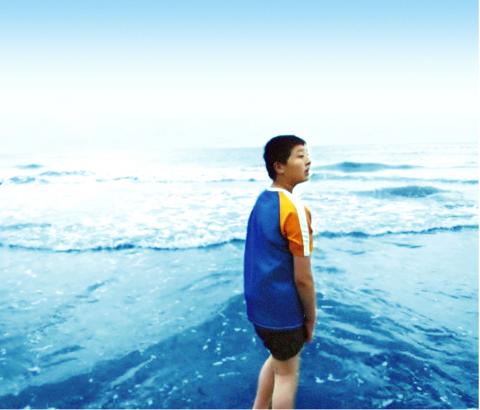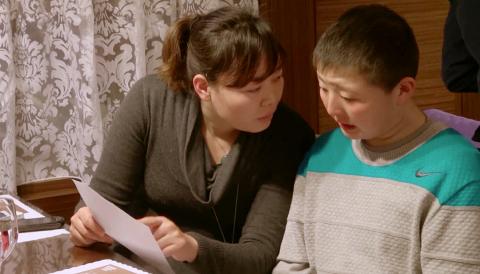“Don’t walk so fast, walk behind me and film my backpack,” says 11-year-old Zhang Zhechen (張澤晨), known as “Chang Chang” (晨晨), at the beginning of Chang Chang Going to School Overseas (晨晨跨海上學去). “You’re too close ... People say I look like Justin Bieber, but it’s not true … I’m the main character, of course I have to be awe-inspiring.”
This scene sets the tone for the rest of the film — it is natural and completely candid. Chang Chang appears to simply be himself, often interacting with the camera operator and making funny statements to the audience, who frequently burst out in laughter during the film’s Taipei screening on Wednesday.
More than once he tells the operator to stop shooting, and there is even a hilarious sequence where he declares his love to a female schoolmate and suggests that they should have a traditional Chinese wedding.

Photo Courtesy of Wu Shwu-mey
Indeed, Chang Chang’s larger-than-life personality drives the narrative, which was filmed over two years. Director Wu Shwu-mey (吳淑美), a Hsinchu University of Education special education professor, who shot most of the film, says that she was forced to include herself in the final cut because Chang Chang kept mentioning her name in the scenes.
“Otherwise people would be wondering, who is this Professor Wu?” she says.
Despite having no filmmaking background, this is Wu’s third documentary about children with disabilities, winning her a Bronze Remi at WorldFest Houston last year.

Photo Courtesy of Wu Shwu-mey
A native of China’s Zhengzhou (鄭州) in Henan Province, Chang Chang was having difficulties at school due to intellectual disabilities and behavioral issues. In the fifth grade, he came to Taiwan to attend an inclusive education school in Hsinchu run by Wu, where special needs and typical students study side by side. Usually, each class is about one-third special needs.
The camera follows him through his everyday life over two years, through the good times and the bad, telling Chang Chang’s story as a human being rather than a child with disabilities.
His exact disability is never mentioned in the film — a conscious decision by Wu, who wanted to let the narrative do the talking. Wu started shooting a few months after Chang Chang started attending school in Hsinchu, so there were no scenes of his previous behavior and how he was like in China, or even when he first arrived.
We do hear about his difficulties and the challenges of dealing with him from his parents, teachers, caretakers and former classmates, and watch his struggles and meltdowns in Taiwan — but the main focus appears to be how his behavior, performance and self-esteem improves as he finds his place in a more accepting environment. You almost forget that he has a disability at one point.
Over two years, Chang Chang visited Taiwan nine times — going back to China for holidays and other reasons as his mother was not able to be with him in Taiwan all the time. But the narrative does not get messy because of this disjointed timeline, even following him back home several times. It is well-organized and briskly paced, making full use of the 70 minutes of running time — it helps that Wu had Liao Ching-sung (廖慶松), best known for his long-time collaboration with Hou Hsiao-hsien (侯孝賢), as editing consultant.
But, as mentioned earlier, it is Chang Chang that captures the audience’s attention and keeps the story moving. It is more than the fact that he is simply hilarious. It is the compassion, the potential, the genuine humanity that exists in a person who was once deemed a lost cause by society and those around him. No drastic events, major conflicts or sharp social commentary actually take place in the film, but maybe that is not needed in every production.
Unfortunately, Wednesday was the only screening of this film in Taiwan due to limited finances, Wu says. It will be released in DVD format at the end of June.

In Taiwan there are two economies: the shiny high tech export economy epitomized by Taiwan Semiconductor Manufacturing Co (TSMC, 台積電) and its outsized effect on global supply chains, and the domestic economy, driven by construction and powered by flows of gravel, sand and government contracts. The latter supports the former: we can have an economy without TSMC, but we can’t have one without construction. The labor shortage has heavily impacted public construction in Taiwan. For example, the first phase of the MRT Wanda Line in Taipei, originally slated for next year, has been pushed back to 2027. The government

July 22 to July 28 The Love River’s (愛河) four-decade run as the host of Kaohsiung’s annual dragon boat races came to an abrupt end in 1971 — the once pristine waterway had become too polluted. The 1970 event was infamous for the putrid stench permeating the air, exacerbated by contestants splashing water and sludge onto the shore and even the onlookers. The relocation of the festivities officially marked the “death” of the river, whose condition had rapidly deteriorated during the previous decade. The myriad factories upstream were only partly to blame; as Kaohsiung’s population boomed in the 1960s, all household

Allegations of corruption against three heavyweight politicians from the three major parties are big in the news now. On Wednesday, prosecutors indicted Hsinchu County Commissioner Yang Wen-ke (楊文科) of the Chinese Nationalist Party (KMT), a judgment is expected this week in the case involving Hsinchu Mayor Ann Kao (高虹安) of the Taiwan People’s Party (TPP) and former deputy premier and Taoyuan Mayor Cheng Wen-tsan (鄭文燦) of the Democratic Progressive Party (DPP) is being held incommunicado in prison. Unlike the other two cases, Cheng’s case has generated considerable speculation, rumors, suspicions and conspiracy theories from both the pan-blue and pan-green camps.

Stepping inside Waley Art (水谷藝術) in Taipei’s historic Wanhua District (萬華區) one leaves the motorcycle growl and air-conditioner purr of the street and enters a very different sonic realm. Speakers hiss, machines whir and objects chime from all five floors of the shophouse-turned- contemporary art gallery (including the basement). “It’s a bit of a metaphor, the stacking of gallery floors is like the layering of sounds,” observes Australian conceptual artist Samuel Beilby, whose audio installation HZ & Machinic Paragenesis occupies the ground floor of the gallery space. He’s not wrong. Put ‘em in a Box (我們把它都裝在一個盒子裡), which runs until Aug. 18, invites